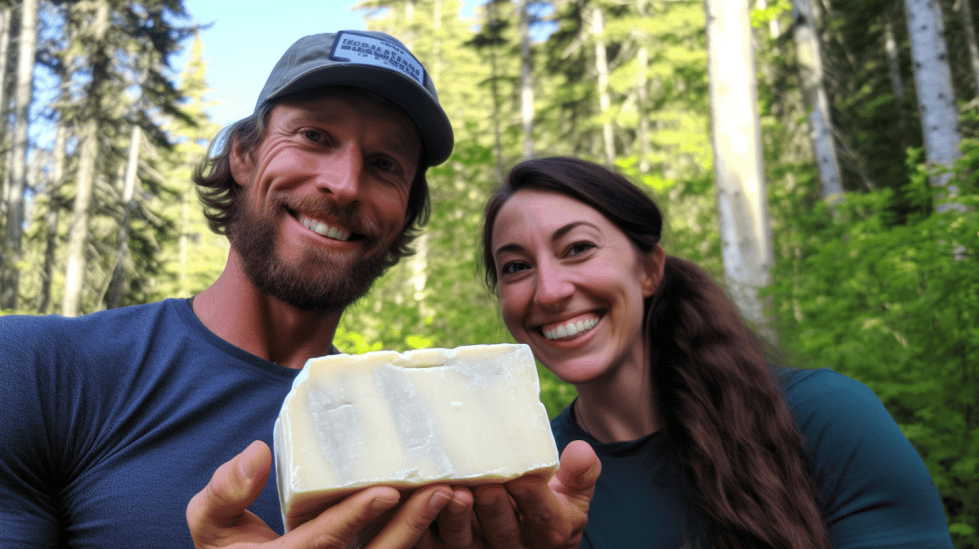How to Make Plant-Based Soap
Making plant-based soap is an excellent choice for those looking to create eco-friendly, cruelty-free, and skin-nourishing products. It only requires a few simple ingredients like distilled water, lye, and plant-based oils, which replace animal fats typically found in traditional soap recipes. With a plethora of plant-based oils available, you can easily customize your plant-based soap to suit your personal preferences and skin needs.
Before diving into soap making, it’s essential to understand the basics and gather the necessary tools and ingredients. Creating your first plant-based soap may seem intimidating, but don’t worry – with a little patience, careful preparation, and attention to safety, you’ll be able to craft a beautiful, gentle, and luxurious soap that you can proudly use or share with others. As you practice and perfect your recipe, you might even find yourself exploring new additives and techniques to take your soap-making adventure to the next level.
Key Takeaways
- Plant-based soap is an eco-friendly and cruelty-free alternative to traditional soap recipes.
- Taking the time to learn the basics and gather necessary ingredients will ensure a successful soap-making experience.
- Along with practice, careful preparation, and consideration of safety precautions, you can create a beautiful, luxurious, and nourishing plant-based soap.
Understanding the Basics of Soap Making
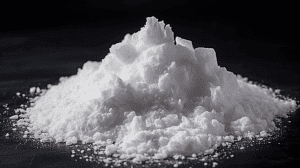
Before diving into the art of making plant-based soap, it’s essential to grasp some fundamental concepts. Soap making is a fascinating process that involves a chemical reaction between oils and lye. This reaction is known as the saponification process, which results in the production of soap and glycerin.
The first component required in soap making is the lye solution. Lye, also known as caustic soda, is a strong alkali that acts as a catalyst in the saponification process. In order to create soap, I must dissolve the appropriate amount of lye in water to form the lye solution. It’s crucial to handle lye with caution, as it can cause burns on skin and eyes upon contact.
The amount of lye used in the soap-making process is essential in determining its final properties. If I use too much lye, the soap may be too harsh and irritate the skin. On the other hand, if I use too little, the resulting soap will be soft and oily, with less effective cleaning properties. To achieve a well-balanced soap, it’s important to carefully measure both the lye and the oils involved.
The choice of oils plays a significant role in the soap’s final character, as each oil contributes different properties. For example, coconut oil provides hardness and lathering abilities, while olive oil contributes moisturizing qualities. In plant-based soap making, I replace animal-derived fats with various plant oils, such as coconut, olive, sunflower, and avocado oil. These plant-based oils offer an excellent alternative without compromising the soap’s quality, and at the same time, they cater to a vegan lifestyle.
By clearly understanding these fundamentals of the soap-making process, I am now equipped with the necessary knowledge to venture into the world of plant-based soap making.
Choosing Your Ingredients
When making plant-based soap, the most important components to consider are the oils and fats, as well as any additional ingredients you’d like to include for fragrance or skin benefits. In this section, I’ll outline how to choose the right oils and fats, and suggest some additional ingredients to consider.
Choosing Oils and Fats
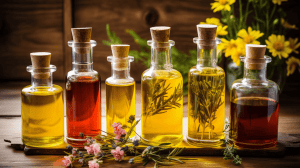
Plant-based soaps replace animal fats with plant oils, which serve as the core ingredient in the soap-making process. There are numerous plant oils to choose from, each with its own unique properties that can affect the final product. Some popular options include:
- Olive oil: Known for its mildness and moisturizing properties. It produces a gentle soap that is suitable for sensitive skin.
- Coconut oil: Creates a rich, bubbly lather and can provide a cleansing effect. However, it can be drying if used in large amounts, so it’s often used in combination with other oils.
- Palm oil: Contributes to a hard, long-lasting bar of soap with good lather quality. Keep in mind that it’s essential to use sustainably sourced palm oil, as unsustainable practices contribute to deforestation.
- Shea butter: Adds creaminess and moisturizing benefits to the soap, while also creating a smooth texture.
- Cocoa butter: Has similar qualities to shea butter, but with a more decadent chocolate scent.
- Avocado oil: Rich in vitamins and nutrients, it’s an excellent choice for moisturizing and nourishing the skin.
- Castor oil: Not only boosts lather but also helps to moisturize the skin. It’s typically used in small amounts, as too much can make the soap sticky.
- Jojoba oil: Technically a liquid wax, it closely resembles the skin’s natural oil, making it a great choice for balancing oil production and moisturizing the skin.
It’s common to use a blend of these oils and fats to achieve a balanced soap with a desirable combination of lathering, moisturizing, and texture qualities.
Choosing Additional Ingredients

In addition to the base oils, you might want to include various additional ingredients that suit your desired soap characteristics. These can range from botanicals to exfoliating agents, natural colorants, and essential oils for fragrance. Some popular choices include:
- Essential oils: As natural fragrance sources, essential oils like lavender, peppermint, tea tree, and lemongrass can be added to the soap recipe. Feel free to experiment with different blends to craft a unique scent.
- Botanicals: Herbs, flowers, or seeds can be added for their skin-supporting properties or for a decorative touch.
- Exfoliating agents: Ingredients like ground oats, coffee grounds, or seeds can be added to create a gently exfoliating soap.
- Natural colorants: Plant-derived materials like spirulina, beetroot powder, or turmeric can add color to your soap without the use of synthetic dyes.
As you can see, there are numerous options when it comes to choosing ingredients for your plant-based soap. Take your time to explore different combinations and create a soap that meets your desired specifications.
Preparing Your Workspace and Tools
Before starting my journey in making plant-based soap, I always make sure my workspace is clean and organized. A tidy workspace ensures that I can find all my required tools easily and focus on the soap-making process. Furthermore, it’s essential to maintain a clean and sanitary environment while working with lye and other ingredients.
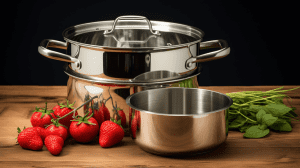
I gather all the necessary kitchen tools before I begin. A stainless steel double boiler is perfect for melting solid oils and butters, as it prevents them from burning or scorching. For mixing the ingredients, I prefer using a stick blender, also known as an immersion blender, as it helps achieve trace much quicker than doing it by hand.
One of the indispensable tools for soap making is a silicone mold or a soap mold. These come in various shapes and sizes and help me create unique designs. Make sure the molds are clean and dry before use, or your soap may not harden or set correctly.
When it comes to safety, I always prioritize protecting my skin and eyes. I wear rubber gloves to prevent any contact with the lye while mixing. Long sleeves also serve as an additional layer of protection for my arms, as lye can cause burns to the skin if I accidentally spill it.
Lastly, I ensure proper ventilation in my workspace by opening windows or working in a well-ventilated area. This allows the fumes from the lye solution and other aromatic ingredients to dissipate safely, keeping the air breathable.
In summary, with a clean and organized workspace, the right tools, and proper safety precautions, I am well prepared to tackle the exciting world of plant-based soap making.
The Recipe: Creating Your First Plant Based Soap
As someone who enjoys making plant-based soap, I want to share some simple recipes to help you create your very own vegan soap. In this section, we’ll go over two methods: a basic cold process soap recipe and a basic melt and pour soap recipe.
A Basic Cold Process Soap Recipe
Creating a natural cold process soap begins with choosing the right ingredients, especially when it comes to oils. I usually go with a blend like this:
- 65% Extra Virgin Olive oil
- 25% Coconut oil
- 10% Castor oil
Next, you’ll need to calculate how much lye and water to use. I strongly recommend using an online lye calculator to determine the right amounts for the specific oils you’ve chosen and the size of your soap batch.
Gather your soap-making equipment, including a scale, stick blender, heat-proof containers, and a soap mold. Start by carefully measuring the oils. Heat the oil mixture gently on the stovetop, and let it cool to around 95°F (35°C).
While the oils are cooling, put on safety gear and slowly mix the lye into the water (never vice versa). This lye water will become hot and produce fumes, so make sure you’re in a well-ventilated area. Once the lye water has cooled to approximately 95°F (35°C), carefully combine it with the oils.
Now, using a stick blender, mix your oils and lye water until they start to thicken into a soap batter. This process is called reaching “trace.” At this point, you can add any desired essential oils or natural ingredients for color and texture. Pour the soap mixture into the mold and let it sit for 24-48 hours to harden. After that, you can remove it from the mold, cut the soap into bars, and let them finish curing for 4-6 weeks.
A Basic Melt and Pour Soap Recipe
Melt and pour soap recipes are perfect if you’re looking for a quicker and more straightforward method for creating your first batch of vegan soap. Here’s what you’ll need:
- A plant-based melt and pour soap base
- Essential oils or fragrances (optional)
- Natural colorants like mica (optional)
- A silicone soap mold or plastic container
Start by cutting your soap base into small cubes and placing them into a heatproof container. You can now melt the cubes in the microwave or use a double boiler. I like melting the base in 30-second intervals, stirring in between until fully melted.
Once your soap base has melted, you can mix in your chosen essential oils and colorants. Remember, less is more when it comes to essential oils, so take it slow. Then, pour the soap mixture into your mold and allow it to harden; this can take a few hours or overnight, depending on the size of your soap.
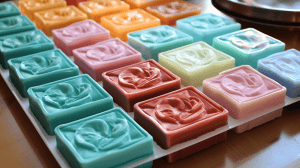
Once hardened, remove the soap from the mold, cut it into bars (if necessary), and enjoy your very own vegan, plant-based soap! It’s that simple.
Safety Precautions in Soap Making
When I make plant-based soap, there are essential safety precautions that I always follow to ensure a safe and successful soap making process.
Firstly, I keep my work area clean and organized, with all materials and ingredients in their proper places. Doing so helps me avoid accidents, like spilling lye or oils. Working at room temperature ensures that the ingredients don’t react unexpectedly.
Using lye is an essential part of soap making, but it can be dangerous if not handled carefully. I always wear gloves, safety goggles, and proper clothing to protect my skin, eyes, and body. If lye comes in contact with skin, it’s crucial to rinse the area immediately with cold water to minimize the damage.

As for heating oils, I heat them gently over low heat to avoid reaching their melting point too quickly. Rapid heating can cause the oils to become too hot, which may lead to a dangerous reaction when combined with lye. I also handle the heated pots and pans with care, using an old towel or pot holders to prevent burns.
In case of spills or accidents, I always have a dedicated cleanup plan in place. This includes having a neutralizing agent (such as vinegar) and cold water on hand to clean up any spills without causing further harm.
It’s essential to follow the proper ratios for lye and oils to create successful, nonirritating soap. I double-check my measurements and calculations before mixing, ensuring a suitable balance that is safe for use on the skin.
Overall, following these safety precautions, I can confidently and correctly make my plant-based soap without any issues.
Adding the Finishing Touches
After carefully crafting my plant-based soap, I like to add some finishing touches to enhance its appearance and fragrance. Whether I’m creating bars of soap or liquid soap, these small details make my handmade soap feel unique and special.
I often start with natural colorants to give my soap a warm and appealing appearance. For instance, I might use paprika for an orange hue or spirulina for a rich green shade. These natural options keep my organic soap free from artificial dyes.
To incorporate enticing aromas, I choose fragrance oils or essential oils, which complement the natural soap base. I prefer to use a blend of essential oils for an invigorating scent, such as a mix of lavender and eucalyptus. When selecting fragrance oils, it’s important to ensure they’re skin-safe and compatible with soap making.
Although glycerin soap and jelly soap offer a unique visual appeal, I’ve found that a hard bar of soap provides a longer-lasting product. To achieve a hard, solid texture that still maintains a lather, I make sure to use the appropriate balance of plant-based oils and ensure a proper curing process.
In addition to bars of soap, I’ve also experimented with making liquid soap. To achieve a smooth consistency, I carefully blend the soap base with the right amount of water. Depending on the type of soap, this may be achieved by diluting a soap paste or starting with a liquid soap concentrate.
For honey soap, I like to add a small amount of raw honey at the end of the process. This not only adds a natural sweetness to the aroma, but also contributes to the moisturizing properties of the finished product.
Lastly, I always consider the presentation of my soap, whether it’s destined for personal use or as a gift. I might use a simple craft paper wrap for a rustic look or a decorative mold to shape the bar soap. Whichever method I choose, the attention to detail enhances the end product and showcases the care I put into making my all-natural, plant-based soap.
Troubleshooting and Perfecting Your Recipe
During my soap making journey, I’ve found that sometimes challenges arise—like properly mixing the lye mixture or choosing the best oils for sensitive skin. In this section, I’ll share some tips on troubleshooting and perfecting your plant-based soap recipe.
In my experience as a soap maker, it’s crucial to properly mix the lye mixture with the carrier oils. If the lye and oils aren’t combined well, it may result in a lumpy or uneven soap. I recommend mixing the lye solution at a temperature of around 100-120°F with liquid oils like extra virgin olive oil or avocado oil. When combining the lye and oils, I gradually pour the lye mixture into the oils while continuously stirring it with a spatula or using an immersion blender at a low speed.
It’s essential to keep a close eye on air bubbles, as they might appear in the soap base while blending. To minimize air bubbles, I avoid blending at high speeds and stick to short bursts of blending. Additionally, I gently tap the soap mold on the countertop after pouring the soap base to release any trapped air bubbles.
As a soap maker, I understand the importance of selecting the right oils for different skin types, especially when it comes to sensitive skin. For sensitive or dry skin, I’ve found that using liquid oils like almond oil or sunflower oil work wonders. On the other hand, for oily skin, I prefer using oils with higher cleansing properties like castor oil or grape seed oil. It’s crucial to determine the best oils for your specific skin type and consider personal preferences when creating a particular recipe.
Lastly, when it comes to adding fragrances to my soap, I choose pure essential oils to keep the soap plant-based and natural. Different essential oils offer various benefits and scents, so I suggest experimenting with a variety of options to find the perfect fragrance for your soap. Just be mindful of the concentration, as some essential oils may cause skin irritation if not diluted properly.
In conclusion, the key to troubleshooting and perfecting your plant-based soap recipe is a combination of understanding your skin type, selecting suitable oils, properly mixing the ingredients, and preventing air bubbles. By following these tips and refining your technique, you’ll be well on your way to creating your perfect plant-based soap.
Frequently Asked Questions
What ingredients are needed for plant-based soap?
For making plant-based soap, you’ll need a combination of plant-based oils, such as olive, coconut, or sunflower oil. You’ll also need lye (sodium hydroxide), distilled water, and any additional ingredients like essential oils or colorants for fragrance and appearance. I recommend using a digital scale to accurately measure the ingredients for your recipe.
What is the process of making natural soap?
Natural soap is made through a process called saponification. It involves mixing lye with water and then combining the lye solution with your plant-based oils. The reaction between the lye and the oils creates soap. I recommend mixing the ingredients using a stick blender for a more even and smooth consistency. Once mixed, pour the soap into a mold and let it harden for a day or two before unmolding and cutting it into bars. Then, allow the soap to cure for 4-6 weeks before using it.
Are there any good palm-free soap recipes?
Yes, there are several palm-free soap recipes available. One popular option is a coconut oil vegan soap bar. This simple recipe requires 454g of refined coconut oil, 66g of lye, and 150g of distilled water. You can also customize this base recipe with essential oils, colorants, or other botanical ingredients to suit your preferences.
How can I create soap using botanical ingredients?
Incorporating botanical ingredients into your soap can add a unique touch and enhance its properties. Some examples include adding dried herbs, flower petals, or ground spices directly to the soap mixture. You can also infuse plant-based oils with botanicals or use essential oils for their scent and therapeutic properties. Experiment with your favorite botanical ingredients to find a combination that works best for you.
Which vegan soap brands are recommended?
There are several vegan soap brands that offer high-quality plant-based soaps. Some of my favorites include Lush, Dr. Bronner’s, and Tom’s of Maine. These brands use cruelty-free methods and prioritize environmentally friendly practices in their production. Explore the options available and choose a brand that aligns with your values and preferences.
What should I include in a vegan soap making kit?
A vegan soap making kit contains everything you need to get started in creating your own plant-based soap. Essentials include a digital scale for accurately measuring ingredients, a soap mold, a stick blender, gloves, and eye protection. Additional items might include essential oils, colorants, and botanical ingredients for customizing your soap creations. With these tools and supplies on hand, you’ll be well-equipped to start making your own vegan soaps.


